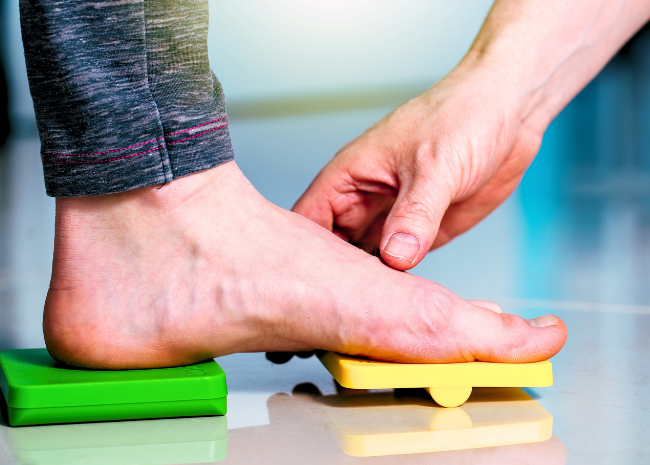
Understanding Posterior Tibial Tendon Dysfunction and Flatfoot Treatment
Let’s dive into something you might be familiar with but maybe not in all its detail: posterior tibial tendon dysfunction (PTTD), commonly known as flatfoot.
Flatfoot is not just about having flat feet; there’s a lot more to it, especially when it develops in adulthood and typically affects just one foot.
What is Posterior Tibial Tendon Dysfunction (PTTD)?
PTTD happens when the posterior tibial tendon, which runs from your calf to the bottom of your foot, tears or gets inflamed. Over time, this causes the arch of your foot to collapse, causing the arch of the foot to fall over time and lead to flatfoot.
Specifically, this type of flatfoot develops during adulthood, is more common in women and folks over 40, and often affects only one foot.
Types of Flat Feet:
- Flexible Flat Feet: Arches appear when sitting or standing on tiptoes but flatten under weight
- Rigid Flat Feet: Permanently flattened arches, regardless of weight-bearing
Causes and Risk Factors:
- Genetics, arthritis, diabetes, aging, obesity, foot or ankle injuries
- High-impact sports
- Can also develop in children whose arches may not fully develop until age 6 or later
Symptoms of PTTD:
- Pain and swelling on the inside of the foot or outside of the ankle
- Pain or achiness in the arch or heel
- Increased pain with activities like walking or running
- Difficulty standing on toes
- Possible knee, hip, or lower back pain due to improper alignment
Flatfoot, or fallen arches, can also result in shin splints and knee problems. Understanding its characteristics and causes is crucial for effective treatment.
Treatment Options for PTTD and Flatfoot
The good news? Most people find relief through conservative measures, though it takes some patience—think three to six months. Here’s a rundown of your options:
- Rest: Switch to low-impact activities like cycling, swimming, or using an elliptical. Sometimes, a boot or small cast can help immobilize the area temporarily
- Physical Therapy: Targeted exercises can strengthen and rehabilitate the tibial tendon. A customized exercise regimen can be designed for your condition
- Orthotics: Shoe inserts, either over-the-counter or custom-made, can help. Custom-made orthotics, though pricier, often control foot position better
- Braces: A lace-up ankle brace can support the back of the foot and ease tension on the tendon
- Massage Techniques: Massage therapy can help relax the muscles and relieve tension in the feet. Techniques such as deep tissue massage and myofascial release can be particularly beneficial.
- Aerobic Exercises: Engaging in low-impact aerobic exercises like swimming or cycling can help improve overall foot and leg strength without putting excessive stress on the arches.
- Avoiding High-Impact Exercises: It’s important to avoid activities that can worsen flat feet, such as running or jumping. These activities can strain the arches and increase pain and discomfort.
If you’re experiencing symptoms of flat feet, consult a qualified healthcare professional or physical therapist who can assess your condition and recommend the most appropriate treatment options for your individual needs.
A healthcare professional will assess your arches, flexibility, and alignment, possibly using imaging tests like X-rays or MRIs.
Choosing Proper Footwear
Choosing the right footwear is crucial when managing flat feet. Supportive shoes can help alleviate discomfort, provide stability, and promote proper alignment of the feet.
Here are some important factors to consider when selecting shoes for flat feet:
- Supportive Shoes: Look for shoes with good arch support and cushioning. Arch support helps maintain the natural arch of the foot, while cushioning provides shock absorption and reduces pressure.
- Avoid shoes with flat soles or minimal support: These shoes can exacerbate flat foot symptoms.
- Orthotic Inserts and Arch Supports: In addition to supportive shoes, orthotic inserts or arch supports can provide extra support and help correct biomechanical issues.
- Footwear Recommendations: Consider brands specializing in footwear for flat feet. Certain brands offer a range of styles with built-in arch support and cushioning.
If you’re considering custom orthotics, we have specialists on staff who can help. Our physical therapists can provide personalized recommendations based on your specific foot structure and needs.
TJC Locations specializing in custom orthotics: Burke, Centreville, Manassas, Alexandria, Arlington, Oakton, Sterling, Tysons, and Worldgate
Recommended Flatfoot Exercises
For those with flat feet, specific exercises can help alleviate discomfort and strengthen the muscles in the feet and legs. Incorporating these exercises into your daily routine can make a significant difference. Here are three recommended exercises:
Recommended Flatfoot Exercises
Incorporating specific exercises into your routine can make a significant difference:
- Heel Stretches:
- Stand facing a wall, hands on the wall for support
- Step back with one foot flat on the ground, bend the front knee, lean forward
- Stretch the calf muscles, hold for 30 seconds, switch legs
- Arch Lifts:
- Sit on a chair, feet flat on the ground
- Press toes into the ground while lifting the arches, keep heels down
- Hold for a few seconds, release, repeat 10 times
- Calf Raises:
- Stand with feet shoulder-width apart
- Rise onto toes, lifting heels off the ground, hold, lower back down
- Repeat 10-15 times
When to Seek Professional Help
If you’re experiencing persistent pain, it’s time to see a professional. Severe deformities or continuous discomfort need a customized treatment plan from a healthcare provider.
At The Jackson Clinics, we can assess your condition and develop a tailored exercise program, guiding you every step of the way.
Did you know you have Direct Access* to Physical Therapy? No referral, no problem!
Reach out to us for a personalized approach to managing flatfoot and PTTD, and let’s get you back on your feet comfortably!









